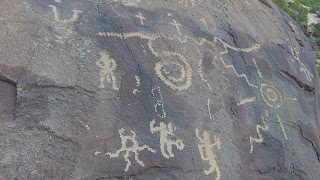Agnes Martin, 1954
Thinking the other day about Agnes Martin and her big exhibition next year at the Harwood Museum, I remembered that Jim Wagner had known her in Taos in the 1960s. It seemed like a most unlikely pairing – Martin who became famous for her spare, nearly monochromatic grid paintings, and Wagner, the master of loose expressionism whose principal subject has long been the off-beat, funky charm of Taos. I asked Wagner to recall his early meetings with Martin:
“When I was growing up in Monmouth, Oregon, we had a family friend, Mildred Kane, who came by the house a lot. She’d been my sister’s kindergarten teacher, and she was a close friend of Agnes Martin. I think they’d gone to college together in Canada. Mildred often visited Agnes when she lived in Taos, it must have been the late 40s and early 50s, I was in the 4th or 5th grade, and she would always tell us these stories about Taos, what a great place it was for an artist, and she’d show us drawings and watercolors that she’d gotten from Agnes. Nothing like the grids she became famous for – these were like nymphs or fairies running through graveyards, that sort of thing. They’re probably still around someplace. I think the Fine Arts Museum in Santa Fe has some.
“Because of Mildred’s stories, I knew Taos was the place to go when I decided to become an artist in the early 1960s. A few years later, in about 1965, I was going into a liquor store, Mundos -- it used to be at the edge of that steep hill at the south end of Placitas Road. Anyway, I remember the day exactly because I’d just had a vasectomy, the pain pills were beginning to wear off and I was getting a bottle of bourbon to take home. So Agnes was in there and I recognized her, she was buying a bottle of Campari, and I introduced myself and told her about Mildred. Well, for whatever reason, she didn’t want to talk about Mildred but she invited me into the back room at Mundos where we sat and drank Campari.
Jim Wagner, c. 1965
“A few weeks later I was having cocktails at Louis Ribak and Bea Mandelman’s house, and Agnes was there. They were old friends. Agnes got pretty loose. We were all going to dinner at the old Casa Cordova restaurant in Seco, and I’ll never forget it, I had to carry Agnes into the dining room on my back. The owner, Godie Schuetz, was so mad at me . . .
“After dinner Agnes and I sat in the car for an hour and talked about art. It wasn’t technical stuff at all, not how to paint or anything but about how art made you feel. It was almost like religion. Listening to her talk was like music just flowing over me. Like liquid gold. I took it all in.”
After hearing Wagner’s story, I looked up a half-remembered quote of Martin’s that pointed toward a possible connection between the two: “If you live intellectually, you live with facts,” Martin said. “If you learn to surrender, you can go to bed, sleep, and then wake up with the answer. You have to surrender to inspiration . . . you have to put the intellect to sleep.”
Jim Wagner, The Committee, etching
“She was the first one to drive that home for me,” Wagner said. “Stop thinking. Let your subconscious do the work. You have to shut out the critics, the voices that want to tell you what you can do, what you can’t do. I call those voices The Committee.”




